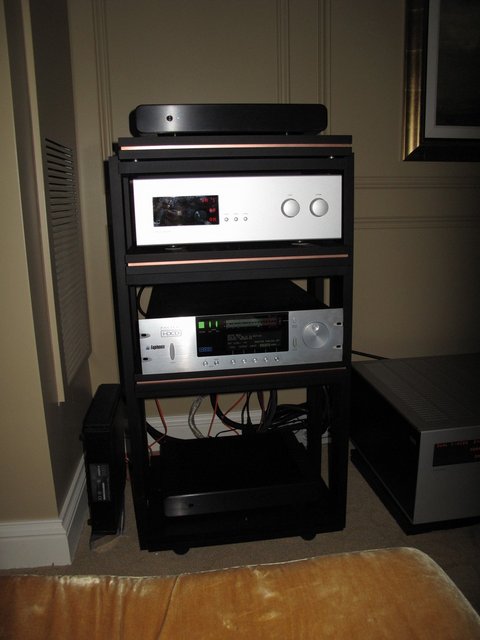During my recent visit to toys-R-us for big boys and girls (a.k.a. CES and T.H.E. 2009) high end music servers were in many rooms. One often had demos where a CD/SACD player and LP spinner sat idle while the tunes streamed digitally off a laptop to the various interfaces. Here we see the equipment rack in the Magico room where a music server is the ONLY source, one I would like to discuss with those of you further up the music server learning curve.
First I will add to the accolades circulating on the net about the sound of this system. Along with the Sonicweld, Manger, Nola, Acapella, and MBL systems the Magico room aptly demonstrated why music lovers of means pay out the long green to park these systems in their abodes. When I visited the Magico room classical music was being played and while it was not some bombastic warhorse like the 1812 cannon shots or The Planets the sound this system produced exhibited a lack or artifact, clarity, tonality, and effortless dynamic ease placing it at the state of the art. At the shows I heard many impressive systems and some musical systems but it was the Magico which most reminded me of the years I kept season tickets to the symphony orchestra.
Onto the gear and the topic I hope to spark a discussion on. First I will go over the known quantities and then the tantalizing ‘black boxes’.

Upper silver box is a Soulution preamplifier (yes it is spelled with the extra ‘u’, see
http://www.soulution-audio.com) a very high end euro solid state piece. Just in the picture is a corner from the pair of the Soulution mono amplifiers which prompted my first reaction upon entering the room “dang, those are BIG amps!” The next silver box has me drooling on my keyboard as I type this, the legendary Pacific Microsonics HDCD analog-to-digital and digital-to-analog converter. The HDCD disks in your collection were likely mastered on one of these I believe now out of production boxes. Very well healed audiophiles use them as DACs. Sitting vertically on the floor to the left of the rack is the outboard power supply for this ADC/DAC.
That brings us to the two unlabeled black boxes on the top and bottom shelves. When I asked the Magico staffer attending the room what is your source I was informed “an in-house built very high quality custom music server, not for sale”. Not surprising given the depth of engineering Magico claims (and can afford thanks to the price tags of their products). The flames of my curiosity were further stoked when I noticed a Squeezebox Controller remote wand sitting in its charger. The Controller (not seen in this photo) offers the user interface of choice for a music server with its RF remote and in hand album art display, however there was no sign of a companion Squeezebox receiver. What is seen is a pair of the proverbial black boxes on the top and bottom shelves. Both boxes have fins on both sides and unlabeled button and blue LED on the front. Like small power amps or my first thought cases for a no-fan quiet PC and/or hard drive case. The final clue is zooming in on the high res picture one can see what I believe to be the signature orange cable of network hub style ST duplex optical cables.
So who is up for “guess what’s in the black boxes” every geeks favorite game? I will get us started with two possible scenarios.
1. Quick easy and the first thought by the cynical ones. The Logitech Duet Squeezebox receiver is repackaged in one of the boxes and the other is a NAS or PC holding the music. Better power supply and tweaks like low jitter clocks and SPDIF transmitter up performance. Upgraded cosmetics address marketing’s concern at seeing $300 source driving $150,000 CES system. Secret of the outstanding sound is the Pacific Microsonics digital-to-analog converter’s jitter rejection on its SPDIF input perhaps helped by using it as the system’s master clock.
2. Technically deeper scenario. The SqueezeCenter software is open source with versions for PC, Mac, and UNIX. The black boxes contain something like a fanless UNIX computer running (perhaps hacked) Squeezeserver and disk(s) with the music files. The best pro-sound 192k/24 bit sound card they could find outputs the bits to the DAC. Here I need those with deep experience in the Squeezebox world to comment. From the Squeezebox Controller remote can one use SqueezeCenter to command a server to output a music data stream at the server rather than from the Squeezebox receiver box? If so is the Squeezebox receiver even needed? In other words does the Controller have its own access to the wireless network or is it talking to the Squeezebox receiver? Would this be a way to get the great Squeezebox user interface and serve up high resolution music files from a server? Or is some part of the receiver required and if so could it be hidden away talking to the server via the network or are parts of the receiver circuit in one of those black boxes?
Truth is I do not care what is in Magico’s black boxes. What I really want is a server as described in scenario #2 for me.